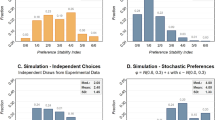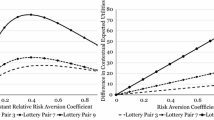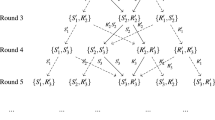Abstract
There are two means of changing the expected value of a risk: changing the probability of a reward or changing the reward. Theoretically, the former produces a greater change in expected utility for risk averse agents. This paper uses two formats of a risk preference elicitation mechanism under two decision frames to test this hypothesis. After controlling for decision error, probability weighting, and order effects, subjects, on average, are slightly risk averse and prefer an increase in the expected value of a risk due to increasing the probability over a compensated increase in the reward. There is substantial across-format inconsistency but very little within-format inconsistency at the individual level.
Similar content being viewed by others
References
Andersen, S. G., Harrison, G., Lau, M. I., & Rutström, E. E. (2006). Elicitation using multiple price list formats. Experimental Economics, 9(4), 383–406.
Andersen, S. G., Harrison, G., Lau, M. I., & Rutström, E. E. (2008). Eliciting risk and time preferences. Econometrica, 76, 583–618.
Anderson, L. R., & Stafford, S. L. (2003). Punishment in a regulatory setting: Experimental evidence from the VCM. Journal of Regulatory Economics, 24, 91–110.
Anderson, L. R., & Stafford, S. L. (2006). Does crime pay? A classroom demonstration of monitoring and enforcement. Southern Economic Journal, 72, 1016–1025.
Ballinger, T. P., & Wilcox, N. T. (1997). Decisions, error and heterogeneity. The Economic Journal, 107, 1090–1105.
Becker, G. S. (1968). Crime and punishment: An economic approach. Journal of Political Economy, 76, 169–217.
Becker, G., DeGroot, M., & Marschak, J. (1963). Stochastic models of choice behavior. Behavioral Science, 8, 41–55.
Block, M. K., & Gerety, V. E. (1995). Some experimental evidence on difference between student and prisoner reactions to monetary penalties and risk. Journal of Legal Studies, 24, 123–138.
Camerer, C. F., & Ho, T.-H. (1994). Violations of the betweeness axiom and nonlinearity in probabilities. Journal of Risk and Uncertainty, 8, 167–196.
Carbone, E. (1998). Investigation of stochastic preference theory using experimental data. Economics Letters, 57, 305–312.
Carbone, E., & Hey, J. D. (1994). Discriminating between preference functionals – A preliminary Monte Carlo study. Journal of Risk and Uncertainty, 8, 223–242.
Carbone, E., & Hey, J. D. (2000). Which error story is best. Journal of Risk and Uncertainty, 20, 161–176.
Dave, C., Eckel, C., Johnson, C., & Rojas, C. (2007). On the heterogeneity, stability, and validity of risk preferences. Unpublished Manuscript, University of Texas at Dallas.
Debreu, G. (1958). Stochastic choice and cardinal utility. Econometrica, 26, 440–444.
Fechner, G. (1860/1966). Elements of psychophysics. New York: Holt, Rinehart and Winston.
Fischbacher, U. (2007). Z-tree – Zurich toolbox for readymade economic experiments – Experimenter’s manual. Experimental Economics, 171–178.
Friedman, D., & Sunder, S. (1994). Experimental methods: A primer for economists. New York: Cambridge University Press.
Goeree, J., Holt, C. A., & Palfrey, T. R. (2003). Risk averse behavior in generalized matching pennies games. Games and Economic Behavior, 45, 97–113.
Gonzalez, R., & Wu, G. (1999). On the shape of the probability weighting function. Cognitive Psychology, 38, 129–166.
Greiner, B. (2004). The online recruitment system ORSEE 2.0 – A guide for the organization of experiments in economics. Working Paper Series in Economics 10, University of Cologne.
Grogger, J. (1991). Certainty vs. severity of punishment. Economic Inquiry, 29, 297–309.
Harless, D. W., & Camerer, C. F. (1994). The predictive utility of generalized expected utility theories. Econometrica, 62(6), 1251–1289.
Harrison, G. W. (2007). Maximum likelihood estimation of utility functions using Stata. Working paper 06-12, Department of Economics, College of Business Administration, University of Central Florida.
Harrison, G. W., & Rutström, E. E. (2008). Research in experimental economics (Vol. 12). Emerald Group Publishing Limited.
Harrison, G. W., Johnson, E., McInnes, M. M., & Rutström, E. E. (2005). Risk aversion and incentive effects: Comment. American Economic Review, 95(3), 897–901.
Hey, J. D. (1995). Experimental investigations of errors in decision-making under uncertainty. European Economic Review, 29, 633–640.
Hey, J. D. (2001). Does repetition improve consistency? Experimental Economics, 4, 5–54.
Hey, J. D. (2005). Why we should not be silent about noise. Experimental Economics, 8, 325–345.
Hey, J. D., & Orme, C. (1994). Investigating generalizations of expected utility theory using experimental data. Econometrica, 62(6), 1291–1326.
Holt, C. A., & Laury, S. K. (2002). Risk aversion and incentive effects. American Economic Review, 92(5), 1644–1657.
Holt, C. A., & Laury, S. K. (2005). Risk aversion and incentive effects new data without order effects. American Economic Review, 95(3), 902–904.
Kahneman, D., & Tversky, A. (1979). Prospect theory an analysis of decision under risk. Econometrica, 47, 263–291.
Knight, F. H. (1921). Risk, uncertainty and profit. Boston: Houghton Mifflin.
LeRoy, S. F., & Singell, L. D. (1987). Knight on risk and uncertainty. Journal of Political Economy, 95(2), 394–406.
Loomes, G., & Sugden, R. (1995). Incorporating a stochastic element into decision theories. European Economic Review, 39, 641–648.
Loomes, G., & Sugden, R. (1998). Testing alternative stochastic specifications for risky choice. Economica, 65, 581–598.
Loomes, G., Moffatt, P. G., & Sugden, R. (2002). A microeconometric test of alternative stochastic theories of risky choice. Journal of Risk and Uncertainty, 24, 103–130.
Luce, D. (1959). Individual choice behavior. New York: Wiley.
Myers, S. B. (1983). Estimating the economic model of crime: Employment versus punishment effects. Quarterly Journal of Economics, February, 157–166.
Polinsky, A. M., & Shavell, S. (2000). The economic theory of public enforcement of law. Journal of Economic Literature, 38, 45–76.
Prelec, D. (1998). The probability weighting function. Econometrica, 66, 497–528.
Rothschild, M., & Stiglitz, J. (1970). Increasing risk: I. A definition. Journal of Economic Theory, 2, 225–243.
Samuelson, P. A. (1952). Probability, utility, and the independence axiom. Econometrica, 20(4), 670–678.
Smith, V. L., & Walker, J. (1993). Monetary rewards and decision cost in experimental economics. Economic Inquiry, 31, 245–261.
Starmer, C., & Sugden, R. (1991). Does the random-lottery incentive system elicit true preferences? An experimental investigation. American Economic Review, 81(4), 971–978.
Stott, H. P. (2006). Cumulative prospect theory’s functional menagerie. Journal of Risk and Uncertainty, 32, 101–130.
Tversky, A., & Kahneman, D. (1992). Advances in prospect theory: Cumulative representation of uncertainty. Journal of Risk and Uncertainty, 5, 297–323.
Wilcox, N. T. (1993). Lottery choice: Incentives, complexity, and decision time. The Economic Journal, 103, 1397–1470.
Wilcox, N. T. (2007). In Risk Aversion in Experiments. Research in Experimental Economics : Vol. 12. Greenwich: JAI.
Wilcox, N. T. (forthcoming). Stochastically more risk averse: A contextual utility approach. Journal of Econometrics.
Witte, A. D. (1980). Estimating the economic model of crime with individual data. Quarterly Journal of Economics, February, 57–84.
Author information
Authors and Affiliations
Corresponding author
Additional information
This research was undertaken at the University of Calgary Behavioural and Experimental Economics Laboratory (CBEEL). I would like to thank Christopher Auld, John Boyce, Glenn Harrison, Michael McKee, Bill Neilson, Rob Oxoby, Christian Vossler, Nat Wilcox, and two anonymous referees for their many helpful comments and suggestions. I would also like to thank participants at the 2007 North American Economic Science Association Meetings where an earlier version of this paper was presented.
Electronic Supplementary Material
Rights and permissions
About this article
Cite this article
Bruner, D.M. Changing the probability versus changing the reward. Exp Econ 12, 367–385 (2009). https://doi.org/10.1007/s10683-009-9219-7
Received:
Accepted:
Published:
Issue Date:
DOI: https://doi.org/10.1007/s10683-009-9219-7




